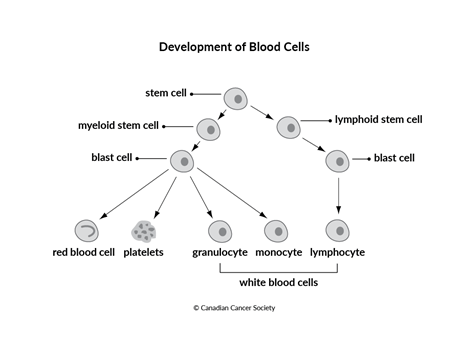What is leukemia?
Leukemia is a cancer that starts in stem cells of the blood. Stem cells are formed in the
Blood (hematopoietic) stem cells develop into either lymphoid stem cells or myeloid stem cells.
- Lymphoid stem cells develop into lymphocytes, a type of white blood cell. Lymphocytes help fight infections and destroy abnormal cells. The 3 types of lymphocytes are B cells, T cells and natural killer (NK) cells.
- Myeloid stem cells develop into red blood cells, platelets, granulocytes and monocytes. Red blood cells carry oxygen around the body. Platelets form clots in damaged blood vessels to stop bleeding. Granulocytes and monocytes are types of white blood cells that help fight infections.
As the stem cells of the blood develop, they become blast cells (blasts), which are immature blood cells. In leukemia, there is an overproduction of blast cells. These blast cells develop abnormally and don’t develop into mature blood cells. Over time, the blast cells crowd out normal blood cells so that they can’t do their jobs. When leukemia is diagnosed, these blast cells may be called leukemia cells.

Find out more about the blood and bone marrow.
Types of leukemia
There are many different types of leukemia. They are grouped based on the type of blood stem cell they developed from. Lymphocytic leukemias (also called lymphoblastic leukemias) develop from abnormal lymphoid stem cells. Myeloid (myelogenous) leukemias develop from abnormal myeloid stem cells.
The types of leukemia are further grouped based on how quickly they develop. Acute leukemias start suddenly, developing within days or weeks. Chronic leukemias develop slowly over months or years.
There are 4 main types of leukemia. Find out more about:
- acute lymphoblastic leukemia (ALL)
- acute myeloid leukemia (AML)
- chronic lymphocytic leukemia (CLL)
- chronic myeloid leukemia (CML)
In adults, CLL and AML are the most common leukemias. There are many different subtypes of leukemia.
The World Health Organization (WHO) classifies a cancer that starts in lymphocytes as a lymphoma, a lymphocytic leukemia or a leukemia/lymphoma. It depends on where the abnormal lymphocytes are found in the body:
If the abnormal lymphocytes are found mainly in the blood or the bone marrow, it is considered a leukemia.
If tumours develop in the lymph nodes or other organs, it is considered a lymphoma.
If the disease is in the blood or the bone marrow and a tumour develops, it is considered a leukemia/lymphoma.
Based on this classification, some rare lymphocytic leukemias are considered types of non-Hodgkin lymphoma (NHL).
Other blood diseases
There are blood diseases that are often discussed along with leukemia, but they have their own separate classification.
Myelodysplastic syndromes (MDSs) are a group of diseases where the bone marrow does not make enough healthy blood cells. MDSs are considered cancer, but they are sometimes called bone marrow failure diseases. An MDS will develop into AML about 30% of the time.
Myeloproliferative neoplasms (MPNs) are a group of blood diseases where the bone marrow makes too many of one or more types of blood cells. MPNs are classified as blood cancers because the blood cells are being made in an uncontrolled way. Certain MPNs may develop into AML.
